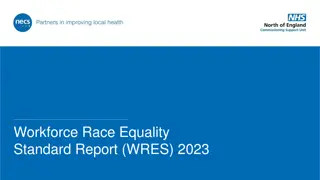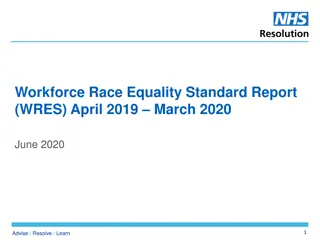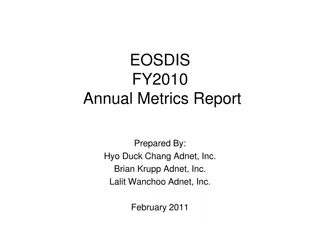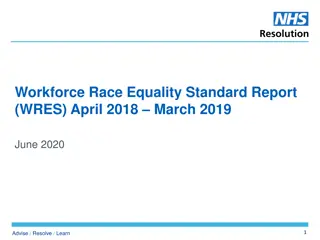Race Equality Data Metrics & Key Indicators in Workplace: An Anti-racism Toolkit
Race Equality Data Metrics & Key Data Indicators play a crucial role in assessing workplace race equality. Developed by Naveed Sharif, this toolkit provides 6 essential metrics focusing on leadership, recruitment, and formal workplace processes. The toolkit aims to address disparities and promote equality for BAME staff in organisations across the North West region. Employers are urged to commit to achieving key outcomes to bridge the gap in representation and treatment of BAME staff within 3 years. Determining benchmarks for performance evaluation and utilizing key indicators are essential steps to ensure progress towards a more inclusive workforce.
Download Presentation

Please find below an Image/Link to download the presentation.
The content on the website is provided AS IS for your information and personal use only. It may not be sold, licensed, or shared on other websites without obtaining consent from the author. Download presentation by click this link. If you encounter any issues during the download, it is possible that the publisher has removed the file from their server.
E N D
Presentation Transcript
Version 1 01st December 2020 Race Equality Data Metrics As part of Anti-racism toolkit Prepared by: Naveed Sharif; Equality, Diversity and Inclusion Manager; NHS England and NHS Improvement, North West Region NHS England and NHS Improvement
North West Region Key Data Indicators The Workforce Race Equality Key Data Indicators (KDI) have been identified by public sector and Trade Union leaders from across the region as the key areas that will allow for the effective benchmarking of organisations performance around workplace race equality. 2 |
Domain One Leadership & Recruitment Key Data Indicator One Percentage of BAME staff at each pay level of the organisation mapped against overall staff in organisation. (Including Executive Board Members) Key Data Indicator Two Likelihood of BAME staff shortlisted and appointed after shortlisting compared with white staff So what are the 6 Metrics? So what are the 6 Metrics? Key Data Indicator Three Measurement of the ethnicity pay gap - Mean & median hourly pay gap between BAME & White staff - Proportion of BAME & White staff receiving a bonus - Distribution of BAME & White staff in each pay quartile - Same methodology as gender pay gap requirements. Domain Two Formal Workplace Processes Key Data Indicator Four Likelihood of BAME staff applications for formal flexible working being successful compared with White staff. Key Data Indicator Five Likelihood of BAME staff being investigated through the formal disciplinary process compared to White Staff Key Data Indicator Six Likelihood of BAME staff being dismissed after entering formal disciplinary process compared to White staff. 3 |
Determining a benchmark Determining a benchmark in Performance in Performance In line with this aspiration, there is a need to determine each organisation s performance against a number of key indicators. Each organisation is asked to measure these in order to ensure our work locally and at system level is constructive, measurable and evidence based, as well as to provide a picture of workforce race equality in practice, to colleagues, organisations, key stakeholders and the public. 4 |
Employers across the North West region should commit to achieving improvements to 3 principle outcomes for BAME staff: That BME applicants will be just as likely to be appointed from shortlisting as white applicants within 3 years; Close the gap in disproportionate rate of disciplinary action between BAME and white staff, such that there will be no difference in the likelihood of BAME and white staff entering the formal disciplinary in the likelihood of BAME and white staff entering the formal disciplinary process within 3 years. That we will see a 19% shift in BME representation into more senior grades in organisations taking into account an organisation s starting position. Key Data Indicator Guidance 5 |
Calculating the key data indicators Key Data Indicator One: Percentage of BAME staff at each pay level of the organisation mapped against overall staff in organisation. (Including Executive Board Members); Key Data Indicator Two: Likelihood of BAME staff shortlisted and appointed after shortlisting compared with white staff: 1. white appointments / White shortlists 2. BAME appointments / BAME Shortlists 3. White answer/BAME Answer Key Data Indicator Three: Measurement of the ethnicity pay gap - Mean & median hourly pay gap between BAME & White staff - Proportion of BAME & White staff receiving a bonus - Distribution of BAME & White staff in each pay quartile - Same methodology as gender pay gap requirements. 6 |
Key Data Indicators Continued: Key Data Indicator Four Likelihood of BAME staff applications for formal flexible working being successful compared with White staff. 1. White successful applicants/ Total White applicants 2. BAME successful applicants/ Total BAME Applicants 3. White answer/BAME Answer Key Data Indicator Five Likelihood of BAME staff being investigated through the formal disciplinary process compared to White Staff 1. Number of white staff entering formal disciplinary/Total number of white staff in the organisation 2. Number of BAME staff entering formal disciplinary/total number of BAME staff in the organisation 3. Divide BAME answer to white answer Key Data Indicator Six Likelihood of BAME staff being dismissed after entering formal disciplinary process compared to White staff. 1. Number of white staff dismissed/ total number of white staff entering the disciplinary process; 2. Number of BAME staff dismissed/total number of BAME staff entering the disciplinary process; 3. BAME answer/White answer 7 |
Analysis of data gathered When analysing and using the information gathered through this exercise, it is important to consider organisational and workforce factors which may affect what the key data indicators actually illustrates in practice. Some examples of such factors may include: Outsourcing of services which may employ a disproportionate number of BAME staff in certain roles, or which employ a disproportionate number of staff at particular pay grades; Overseas recruitment activities which may result in a higher number of BAME staff represented in certain roles or pay grades; Response rates to questions concerning race in equality monitoring processes could affect the data, and may differ between different parts of an organisation; 8 |
Analysis of data: The conditions against which performance is measured may impact the data. For example, if an organisation is undergoing a merger, a major restructure or is under exceptional financial pressures that may impact on data indicators. Not one of these pressures means race equality monitoring is any less important. In fact, it is even more important in those circumstances in ensuring equality remains central to strategy. Caution should be exercised in assuming that organisations whose data are better are engaged in better practice than those who are not. Indeed, some of the best practice is being undertaken by organisations where relatively poor data have spurred the board and others into taking determined action to redress unfair outcomes. 9 |
In light of the above aforementioned, the key indicators do not necessarily represent a definitive measure of an organisation s performance in themselves. They are however a vital early step in assessing current performance and planning action towards the goal of achieving race equality in the workplace. The shared North West Regional vision is that a detailed analysis of workforce data, using these key indicators, will provide an evidence base to enable organisations to better understand their current performance and identify areas which may require further understanding and attention. This in turn will enable your organisation to collaborate effectively in addressing any organisational challenges, sharing and championing learning and good practice and working together to achieve the desired outcomes of the national Workforce Race Equality Standards (WRES) As well as sharing their key data indicators with your organisations, we encourage each organisation to share and discuss their KDIs with senior leaders and key stakeholders, such as recognised trades unions, at an early stage. We also encourage early engagement and consultation with trades unions and other key stakeholders regarding next steps, to promote a collaborative approach not only to data analysis, but also the design and implementation of an organisational strategy on race equality. 10 |
Credits NAVEED SHARIF : EQUALITY DIVERSITY AND INCLUSION MANAGER : WRES NHS ENGLAND / IMPROVEMENT : NORTH WEST REGION : NAVEED.SHARIF2@NHS.NET KEY DATA INDICATORS (GREATER MANCHESTER); WORKFORCE RACE EQUALITY STANDARDS (WRES). Naveed.sharif2@nhs.net 11 |























